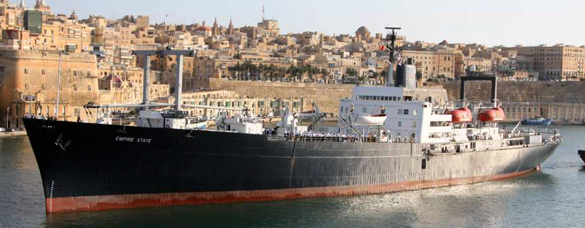Maritime training has evolved over the centuries from an  apprenticeship-type education into a formal course of study. From the early days, hands-on experience has proven invaluable to future seafarers, where one would learn by practicing the procedures and using the tools of the trade. Today, that tradition continues, through the use of both computer simulators and hands-on experience, not to mention more formal training in math, science, navigation, engineering, international law, ship security, and protection of the marine environment.
apprenticeship-type education into a formal course of study. From the early days, hands-on experience has proven invaluable to future seafarers, where one would learn by practicing the procedures and using the tools of the trade. Today, that tradition continues, through the use of both computer simulators and hands-on experience, not to mention more formal training in math, science, navigation, engineering, international law, ship security, and protection of the marine environment.
In our Hall of Maritime Training, we trace the development of maritime training through the history of the State University of New York (SUNY) Maritime College and its training ships, the oldest institute of its kind in the United States, and one of the largest and highly respected in the world.
Established in 1874 as the New York Nautical School (NYNS), the college’s history of training seafarers began aboard its first training ship, the U.S.S. St. Mary’s.
U.S.S. St. Mary’s (1874-1908)
The U.S.S. St. Mary’s, built in the Washington, D.C. Navy Yard i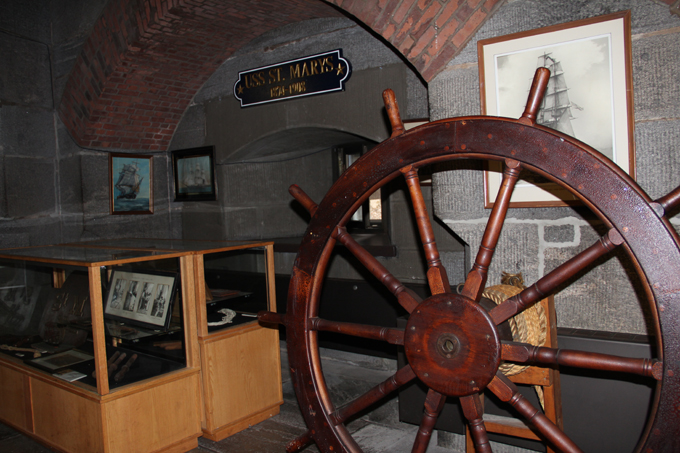 n 1844, was named for the first colonial settlement in Maryland. She was 149 feet, 3 inches in length, had a tonnage of 766, and had an original battery of twenty guns. Her main truck towered 150 feet above the spar deck. Following her commissioning as a naval vessel in 1844, she cruised with the Home Squadron and saw active service in the Mexican War taking part in the capture of Tampico in 1846 and later brought home trophies captured during the Mexican campaign. From 1848 to 1873, the St. Mary’s was attached to the Pacific and Asiatic Squadrons, and in 1860, her sailors and marines cooperated with the forces aboard H.B.M.S. Clio, in quelling insurrections at Panama. In 1873, upon arrival at Norfolk, Virginia the vessel was laid up. The St. Mary’s was one of the fastest sailing ships of her time. She was one of the ships in Admiral Perry’s fleet which opened up Japan in 1850 and was a sister ship of the U.S.S. Saratoga which also took part in that historic voyage to the Japanese Empire.
n 1844, was named for the first colonial settlement in Maryland. She was 149 feet, 3 inches in length, had a tonnage of 766, and had an original battery of twenty guns. Her main truck towered 150 feet above the spar deck. Following her commissioning as a naval vessel in 1844, she cruised with the Home Squadron and saw active service in the Mexican War taking part in the capture of Tampico in 1846 and later brought home trophies captured during the Mexican campaign. From 1848 to 1873, the St. Mary’s was attached to the Pacific and Asiatic Squadrons, and in 1860, her sailors and marines cooperated with the forces aboard H.B.M.S. Clio, in quelling insurrections at Panama. In 1873, upon arrival at Norfolk, Virginia the vessel was laid up. The St. Mary’s was one of the fastest sailing ships of her time. She was one of the ships in Admiral Perry’s fleet which opened up Japan in 1850 and was a sister ship of the U.S.S. Saratoga which also took part in that historic voyage to the Japanese Empire.
The St Mary’s was commissioned as the training ship for the New York Nautical School in 1874 and served in this capacity until February 1908. On November 14th of that year, the dismasted and dismantled hull was burned at Point of Pines, Massachusetts, for the purpose of getting the copper that was in her. Her history closely parallels that of the U.S.S. Saratoga which ended her active service about the same time after a colorful career. The Forty-five ensign that flew at the gaff of the St. Mary’s when she was decommissioned in 1908 is on display in the museum. This very flag was flown by the second U.S.S. St. Mary’s in Tokyo Harbor during the Japanese surrender of World War II. This second U.S.S. St. Mary’s was under the command of Captain E. R. Glosten (NYNS Class of 1908), and took an honored place in the hard hitting forces of Admiral Nimitz.
Also on display at the museum is the original ship’s helm, plus numerous artifacts collected by the former crew and cadets of the St. Mary’s, which helps to depict what seafaring and maritime education were like during the latter part of the 19th century.
U.S.S. Newport (1908-1931)
At the end of the 19th century steam had begun to replace 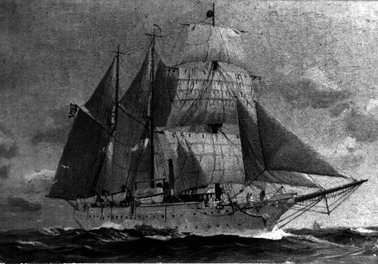 sails. The U.S.S. Newport, built in 1895 and having seen action in Cuba during the Spanish-American War, was fitted with a triple-expansion steam engine in addition to her sails. This provided the cadets of the New York Nautical School a far better training platform during the transition from sail-powered vessels to the new age of steamships.
sails. The U.S.S. Newport, built in 1895 and having seen action in Cuba during the Spanish-American War, was fitted with a triple-expansion steam engine in addition to her sails. This provided the cadets of the New York Nautical School a far better training platform during the transition from sail-powered vessels to the new age of steamships.
U.S.S. Empire State I (1931-1946) ex-U.S.S. Shaume, ex-U.S.S. Procyon (AG-11), ex-American Pilot
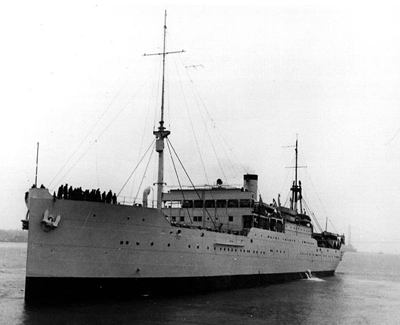 4The first training ship to bear the name Empire State, the ship had a length of 390’ and a beam of 54’. Her displacement was 5,524 gross tons. She was the 37th keel laid on July 18, 1918 on Slipway #17. She was launched on May 13, 1919. The 27th “Hog Islander” launched, she was christened U.S.S. Shaume by Mrs. W.H. White. Through extensive research, there appears to be no actual service record for the Empire State under its original launch name of Shaume. She was reassigned to serve a cargo ship for the Navy and was commissioned on November 30, 1921 as the U.S.S. Procyon. The Procyon’s new assignment was to serve as flagship of the Commander’s Fleet Base Force, U.S. Battle Fleet. Her duty was to lead the supply train in the Pacific.
4The first training ship to bear the name Empire State, the ship had a length of 390’ and a beam of 54’. Her displacement was 5,524 gross tons. She was the 37th keel laid on July 18, 1918 on Slipway #17. She was launched on May 13, 1919. The 27th “Hog Islander” launched, she was christened U.S.S. Shaume by Mrs. W.H. White. Through extensive research, there appears to be no actual service record for the Empire State under its original launch name of Shaume. She was reassigned to serve a cargo ship for the Navy and was commissioned on November 30, 1921 as the U.S.S. Procyon. The Procyon’s new assignment was to serve as flagship of the Commander’s Fleet Base Force, U.S. Battle Fleet. Her duty was to lead the supply train in the Pacific.
On April 1, 1931, the U.S.S. Procyon was decommissioned after ten years of naval service and was passed to the New York State Education Department. She was renamed Empire State on the suggestion of Governor Franklin D. Roosevelt. Her maiden voyage as the Empire State was in 1932 where she visited the ports of Albany, NY; Washington, D.C.; Baltimore, MD; Norfolk, VA; Jacksonville, Miami, and Tampa, FL; New Orleans, LA; Galveston, TX; Gravesend, England; and Le Havre, France.
When the United States entered World War II, the government needed Merchant Mariners to sail on their merchant fleet and supply the troops, so the Empire State was turned over to the Maritime Commission and renamed the American Pilot. The training at the New York State Maritime Academy was accelerated to meet the demand of sailors that the war needed. The ship became not only a New York Maritime Training ship but became the training ship for the Maine and Massachusetts Maritime schools as well. The ship trained some 2,000 men. During this time of war, the American Pilot was confined to the waters of the Long Island Sound due to the risk of German U-Boats in the waters off the east coast of the United States. Upon the end of World War II, the American Pilot was once again renamed Empire State, and in 1946, the ship was replaced as the NYSMA’s training by the Empire State II. In 1948, the Empire State went for demolition at the Wilmington, Delaware scrap yards of American Shipbreakers.
T.S. Empire State II (1946-1956) ex-U.S.S. Hydrus (AKA-28)
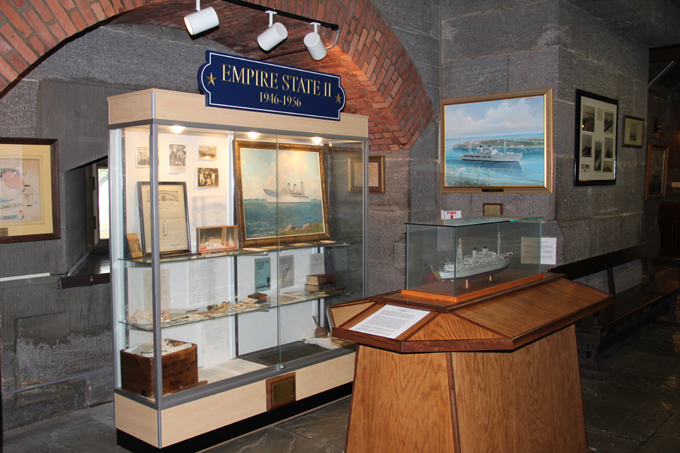 The T.S. Empire State II was originally launched as the U.S.S. Hydrus under the Maritime Commission contract with Walsh-Kaiser Co., Inc., Providence, R.I., on October 28, 1944. The Hydrus served in the Pacific Theater during World War II, first sailing for Guadalcanal to participate in training exercises for the eventual invasion of Okinawa. She was a part of Task Force 53 which transported marines and their equipment to the beaches of Okinawa, arriving at Okinawa on April 1, 1945 under the command of Vice Adm. Kelly Turner. For her operations in the invasion of Okinawa, the Hydrus received 1 battle star. In May 1945, the Hydrus began operations as an inter-island cargo carrier, transporting supplies to the many islands in Hawaii, Christmas Island, and Canton Island. In August, she returned to Okinawa where she remained at anchor until September. The Hydrus’ next mission was to help stabilize China, bringing in units from the Marine Air Group for the occupation of China. During the years of 1945 and 1946, the Hydrus, having completed her mission in China, was assigned to a new mission, Operation Magic-Carpett, the gigantic operation for the return of Pacific and European Veterans to America. She sailed from Shanghai on December 6, and arrived in Seattle on December 23, 1945. Following the end of World War II, the Hydrus was no longer needed for military service and became the new training ship for the New York State Maritime Academy. She was christened as Empire State II in an impressive ceremony attended by Governor Thomas E. Dewey. The Empire State II’s maiden voyage was in 1946, calling in Hamilton, Bermuda; Cristobal and Balboa, Panama Canal Zone; Callao, Peru; Havana, Cuba; and St. Petersburg, FL. The Empire State II served the school for ten years between 1946 and 1955. After her career as the Empire State II, the ship was placed in the Maritime Commission’s National Defense Reserve Fleet in the Hudson River. She remained there until being sold in April 1964 to Union Minerals & Alloys Corp. of New York and scrapped.
The T.S. Empire State II was originally launched as the U.S.S. Hydrus under the Maritime Commission contract with Walsh-Kaiser Co., Inc., Providence, R.I., on October 28, 1944. The Hydrus served in the Pacific Theater during World War II, first sailing for Guadalcanal to participate in training exercises for the eventual invasion of Okinawa. She was a part of Task Force 53 which transported marines and their equipment to the beaches of Okinawa, arriving at Okinawa on April 1, 1945 under the command of Vice Adm. Kelly Turner. For her operations in the invasion of Okinawa, the Hydrus received 1 battle star. In May 1945, the Hydrus began operations as an inter-island cargo carrier, transporting supplies to the many islands in Hawaii, Christmas Island, and Canton Island. In August, she returned to Okinawa where she remained at anchor until September. The Hydrus’ next mission was to help stabilize China, bringing in units from the Marine Air Group for the occupation of China. During the years of 1945 and 1946, the Hydrus, having completed her mission in China, was assigned to a new mission, Operation Magic-Carpett, the gigantic operation for the return of Pacific and European Veterans to America. She sailed from Shanghai on December 6, and arrived in Seattle on December 23, 1945. Following the end of World War II, the Hydrus was no longer needed for military service and became the new training ship for the New York State Maritime Academy. She was christened as Empire State II in an impressive ceremony attended by Governor Thomas E. Dewey. The Empire State II’s maiden voyage was in 1946, calling in Hamilton, Bermuda; Cristobal and Balboa, Panama Canal Zone; Callao, Peru; Havana, Cuba; and St. Petersburg, FL. The Empire State II served the school for ten years between 1946 and 1955. After her career as the Empire State II, the ship was placed in the Maritime Commission’s National Defense Reserve Fleet in the Hudson River. She remained there until being sold in April 1964 to Union Minerals & Alloys Corp. of New York and scrapped.
T.S. Empire State III (1956-1959) ex-U.S.S. Mercy (AH-8)
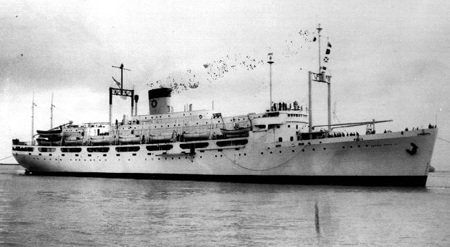 The Empire State III was originally the U.S.S. Mercy. This ship was laid down as hull number 338 under the Maritime Commission contract by the Consolidated Steel Corporation at Wilmington, California, on February 4, 1943. When completed, she was 416’ long, had a beam of 60’-2”, and displaced 11,250 tons.The Mercy was the second of three Navy hospital ships being converted from C1-B cargo ships. This was carried out by the Los Angeles shipbuilding and dry dock company, San Pedro. The Mercy had a compliment of 516 personnel; the medical compliment was made up of the 214th Army Hospital Ship Company. The Mercy facilities rivaled those of the best equipped land hospitals. There were 700 beds covered with new blankets and a bright clean, well-equipped operating room, never before used. Hidden in the depths of the ship was a refrigerated morgue, but it was never used because in most cases burial at sea was much easier. Some of the ship’s rooms were also equipped with temperature control that could be raised to body temperature in about one half hour. The Mercy was so well-equipped and played out, that the emergency rooms were scattered around the ship so if it was hit in any place, the attack would not immobilize the ship. As provided by the Geneva Convention, Mercy was painted all white and traveled completely illuminated at night. The ship’s noncombatant status was displayed by the large red crosses on its decks, smokestack, and sides, as well as a wide green stripe running its full length of both sides.
The Empire State III was originally the U.S.S. Mercy. This ship was laid down as hull number 338 under the Maritime Commission contract by the Consolidated Steel Corporation at Wilmington, California, on February 4, 1943. When completed, she was 416’ long, had a beam of 60’-2”, and displaced 11,250 tons.The Mercy was the second of three Navy hospital ships being converted from C1-B cargo ships. This was carried out by the Los Angeles shipbuilding and dry dock company, San Pedro. The Mercy had a compliment of 516 personnel; the medical compliment was made up of the 214th Army Hospital Ship Company. The Mercy facilities rivaled those of the best equipped land hospitals. There were 700 beds covered with new blankets and a bright clean, well-equipped operating room, never before used. Hidden in the depths of the ship was a refrigerated morgue, but it was never used because in most cases burial at sea was much easier. Some of the ship’s rooms were also equipped with temperature control that could be raised to body temperature in about one half hour. The Mercy was so well-equipped and played out, that the emergency rooms were scattered around the ship so if it was hit in any place, the attack would not immobilize the ship. As provided by the Geneva Convention, Mercy was painted all white and traveled completely illuminated at night. The ship’s noncombatant status was displayed by the large red crosses on its decks, smokestack, and sides, as well as a wide green stripe running its full length of both sides.
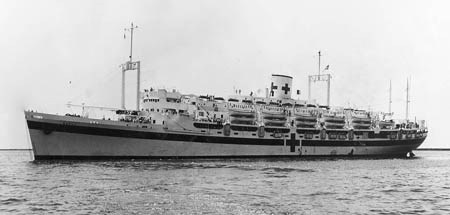 The Mercy was assigned to operate with the 5th and 7th fleets. She departed San Pedro, 31 August 1944 for the South Pacific, and after calls at Pearl Harbor and Eniwetok, arrived at Hollandia, New Guinea, 14 October 1944. When General MacArthur returned to the Philippines, the Mercy knew she was going to be needed. The Mercy arrived at the Leyte Gulf on what is known as D-Day+5, October 25, 1944. Mercy being the first hospital ship there, boarded over 400 wonder in just a few hours. During the next five months, Mercy completed seven more voyages from Leyte to Manus, or Hollandia. The Mercy’s next mission was with the 5th fleet which was serving in the Okinawa campaign that started 1 April 1945. On two missions, Mercy carried over 700 patients each time, utilizing tables and cots in the forward mess to accommodate those in excess of normal capacity. The Mercy also had missions during the Korean War. In 1956, the Mercy was turned over to the New York State Maritime Academy and was renamed Empire State III. Her Maiden Voyage as Empire State III in 1956 took her to the ports of Bermuda, LeHavre, Gothenberg, Copenhagen, London, and Cadiz. The Empire State III served the school for four years. Its last voyage was in 1959 and was to the European ports of Plymouth, Oslo, Santander, Marseilles, and Funchal. Empire State III was returned to the reserve fleet and was there another 11 years before being sold for scrapping in June 1971. The ship was scrapped in Valencia, Spain.
The Mercy was assigned to operate with the 5th and 7th fleets. She departed San Pedro, 31 August 1944 for the South Pacific, and after calls at Pearl Harbor and Eniwetok, arrived at Hollandia, New Guinea, 14 October 1944. When General MacArthur returned to the Philippines, the Mercy knew she was going to be needed. The Mercy arrived at the Leyte Gulf on what is known as D-Day+5, October 25, 1944. Mercy being the first hospital ship there, boarded over 400 wonder in just a few hours. During the next five months, Mercy completed seven more voyages from Leyte to Manus, or Hollandia. The Mercy’s next mission was with the 5th fleet which was serving in the Okinawa campaign that started 1 April 1945. On two missions, Mercy carried over 700 patients each time, utilizing tables and cots in the forward mess to accommodate those in excess of normal capacity. The Mercy also had missions during the Korean War. In 1956, the Mercy was turned over to the New York State Maritime Academy and was renamed Empire State III. Her Maiden Voyage as Empire State III in 1956 took her to the ports of Bermuda, LeHavre, Gothenberg, Copenhagen, London, and Cadiz. The Empire State III served the school for four years. Its last voyage was in 1959 and was to the European ports of Plymouth, Oslo, Santander, Marseilles, and Funchal. Empire State III was returned to the reserve fleet and was there another 11 years before being sold for scrapping in June 1971. The ship was scrapped in Valencia, Spain.
T.S. Empire State IV (1959-1973) ex-Biloxi, ex-U.S.N.S. Henry Gibbins (T-AP-183)
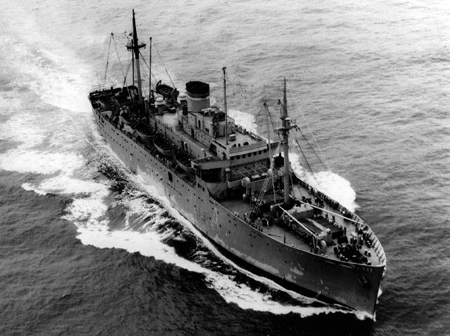 Empire State III began to show signs of wear and tear as a result of the extensive use of the vessel in World War II and a replacement was sought.
Empire State III began to show signs of wear and tear as a result of the extensive use of the vessel in World War II and a replacement was sought.
The U.S.N.S. Henry Gibbins was available and selected. The Gibbins, an Army transport launched in 1942 as the Biloxi, was delivered to the Army Transportation Service on February 27, 1943. She was renamed Henry Gibbins and saw service in the European Theater during World War II. She was made famous in the book Haven which recounted the memorable voyage in 1944 when she carried 1000 Jewish Refugees from Italy to the United States under an order signed by President Franklin Delano Roosevelt.After the war, the Gibbins transported war brides from Europe to the United States. In 1950, she was transferred to the Navy's Military Sea Transportation Service and was used extensively as a troop transport until 1959. In 1959, she was transferred to the Maritime Administration, renamed Empire State IV and assigned as the newest training ship for the New York Maritime College. She had excellent spaces for training ship use and also had two geared turbines which served the engineering cadets well.
T.S. Empire State V (1973-1990) ex-S.S. President Jackson, ex-U.S.N.S. Barrett (T-AP-196)
Laid down in 1949 as the S.S. President Jackson for the passenger service of American President Lines, she never entered that service. Instead, she was commandeered by the federal government and renamed U.S.N.S. Barrett for service as a transport in the Pacific during the Korean and Vietnam Wars. Younger than Empire State IV, she provided better space and more modern equipment for the training of cadets.
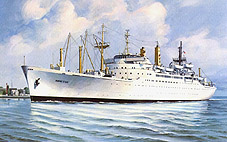
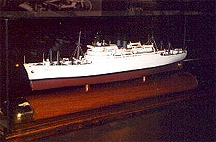
T.S. Empire State VI (1990-Present) ex-S.S. Oregon, ex-S.S. Mormactide
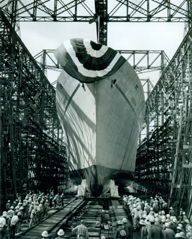 Maritime College’s current current training ship was laid down as the S.S. Oregon at Newport News Shipbuilding and Drydock Company, in Newport News, Virginia, and was launched on September 16, 1961. She was delivered to her owners, States Steamship Company, in February of 1962 for service in the Pacific trades. In the 1970s, the vessel was purchased by Moore McCormack Lines for the South American trade. She was renamed Mormactide and operated by that company until 1982 when she was taken out of service. The vessel changed ownership on more time. United States Lines purchased the vessel but did not have the opportunity to operate her. She was turned over to the Federal Government and laid up in the Reserve Fleet in the James River in December 1982. In November of 1988, the Mormactide was taken under tow through the St. Lawrence Seaway to Bay Shipbuilding Corporation in Sturgeon Bay, Wisconsin. There the vessel was converted to a public nautical training ship and renamed Empire State VI. She was delivered to the State University of New York Maritime College on December 31, 1989.
Maritime College’s current current training ship was laid down as the S.S. Oregon at Newport News Shipbuilding and Drydock Company, in Newport News, Virginia, and was launched on September 16, 1961. She was delivered to her owners, States Steamship Company, in February of 1962 for service in the Pacific trades. In the 1970s, the vessel was purchased by Moore McCormack Lines for the South American trade. She was renamed Mormactide and operated by that company until 1982 when she was taken out of service. The vessel changed ownership on more time. United States Lines purchased the vessel but did not have the opportunity to operate her. She was turned over to the Federal Government and laid up in the Reserve Fleet in the James River in December 1982. In November of 1988, the Mormactide was taken under tow through the St. Lawrence Seaway to Bay Shipbuilding Corporation in Sturgeon Bay, Wisconsin. There the vessel was converted to a public nautical training ship and renamed Empire State VI. She was delivered to the State University of New York Maritime College on December 31, 1989.
